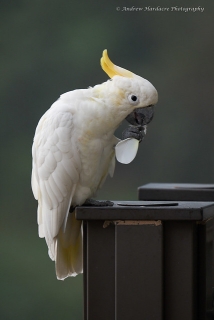Yellow-crested Cockatoo |
|
|
Also known as: Lesser Sulphur-crested Cockatoo, Dwarf Sulphur-crested Cockatoo, Timor Cockatoo
Photos
View in GalleryDid You Know?
The Yellow-crested Cockatoo may also tackle large coconuts (Cocos nucifera) for food.Programs & Projects
WPT has worked with numerous partners to help save this species. Learn moreAcademic Research
Related publications: Cacatua sulphureaSpecies Profile
Genus: Cacatua | Species: sulphurea
Size:
33cm (12.8 in)
Weight:
308-380g (10.8-13.3 oz)
Subspecies including nominate:
three: C.s. sulphurea, C.s. parvula, C.s. abbotti
Colour Adult:
C.s. sulphurea: Both adults white plumage with yellow at bases of feathers of head and underparts; bright yellow crest and ear coverts. Eye ring soft white. Eye dark brown in male, brown/red in female.
C.s. parvula: Both adults as in sulphurea, but yellow ear coverts paler and feather bases less yellow where mentioned.
C.s. abbotti: Both adults as in parvula but larger in size.
Colour Juvenile:
C.s. sulphurea: As in adult, but with pale grey eye.
C.s. parvula: As in adult.
C.s. abbotti: As in adult.
Call:
Call a harsh screech, less raucous than that of the Sulphur-crested Cockatoo. May also emit sweeter squeaky notes and whistles.
Listen NowMore Information:
Content Sources:
CITES
BirdLife International
Cornell Lab of Ornithology/Birds of the World
A Guide to Parrots of the World, Juniper and Parr, 1998
Parrots: Status Survey and Conservation Plan 2000-2004, Snyder, McGowan, Gilardi and Grajal, 2000.
Parrots of the World, Forshaw and Cooper, 1977. 2010 edition
Vanished and Vanishing Parrots, Forshaw, 2017.
Parrots of the World, Forshaw, 2006.
Parrots in Aviculture, Low, 1992.
Psittacine Aviculture, Schubot, Clubb and Clubb, 1992.
Photos
View in GalleryDid You Know?
The Yellow-crested Cockatoo may also tackle large coconuts (Cocos nucifera) for food.Programs & Projects
WPT has worked with numerous partners to help save this species. Learn moreAcademic Research
Related publications: Cacatua sulphureaSpecies Care
Captive Status:
Once the best-known cockatoos outside Australia; less common since 1980s.
Longevity:
40-60 yrs
Housing:
Walk-in aviary, minimum length 4.5m (14.7 ft).
Diet:
Mix of small seeds: canary, oats, safflower; spray millet; limited sunflower seed, dry, soaked or sprouted; sprouted pulses such as mung beans, cooked butterbeans and lentils; boiled maize; green leaves such as: Swiss chard, lettuce, sowthistle, dandelion, chickweed; fresh vegetable such as: corn, carrot, celery, zucchini, green beans or peas in the pod; fruit such as: apple, pear, orange, cactus fruits and bananas; nuts such as: walnuts, hazelnuts, pecans and roasted peanuts; complete kibble.
Enrichment:
Socialization, bathing using overhead misters or misting bottles; chew toys (made of bird-safe wood and vegetable tanned leather), fir, willow, pine and elder branches, different sized perches.
Nest Box Size:
12" x 12" x 24" (30.5cm x 30.5cm x 61cm) or 12" x 12" x 36" (30.5cm x 30.5cm x 91.5cm) vertical box.
Clutch Size:
2, sometimes 3
Incubation Time:
28 days
Fledging Age:
10-12 weeks
Hatch Weight:
8-15g (0.3 oz)
Peak Weight:
314-404g (11-14.1 oz)
Weaning Weight:
236-366g (8.2-12.8 oz)
Photos
View in GalleryDid You Know?
The Yellow-crested Cockatoo may also tackle large coconuts (Cocos nucifera) for food.Programs & Projects
WPT has worked with numerous partners to help save this species. Learn moreAcademic Research
Related publications: Cacatua sulphureaSpecies Wild Status
World Population:
Estimated at 1800-3140 birds.
IUCN Red List Status:
Critically Endangered
CITES Listing:
Appendix I
Threat Summary:
Has suffered steep declines (> 80%) because of widespread forest clearance and unsustainable trapping for trade.
Range:
C.s. sulphurea: Sulawesi and nearby islands, and islands in Flores Sea. Introduced to Hong Kong and Singapore.
C.s. parvula: Nusa Penida and throughout Nusa Tenggara (except Sumba).
C.s. abbotti: Restricted to Masakambing Island, Java Sea.
Habitat:
Found up to 1200m (3936 ft). Occurs in forest edge, woodland, farmland, coconut palms, semi-arid areas and forest.
Wild Diet:
Eats seeds, berries, flowers and leaves and leaf buds. Also will take bananas, mangoes, papaya, figs, guavas, coconuts and other cultivated fruits.
Ecology and Behaviour:
Usually encountered in pairs or small groups of up to ten birds. Larger flocks will gather to feed in fruiting trees. Are noisy and conspicuous. Groups leaving roosting areas in the mountains will fly down to lower elevations to feed. Love to rain-bathe.
Clutch and Egg Size:
2, sometimes 3, elliptical eggs, 41.0 x 27.0mm (1.6 x 1 in).
Breeding Season:
On Buton September-October beginning; Nusa Tenggara April-May. Nests in tree cavity.
Photos
View in GalleryDid You Know?
The Yellow-crested Cockatoo may also tackle large coconuts (Cocos nucifera) for food.Programs & Projects
WPT has worked with numerous partners to help save this species. Learn moreAcademic Research
Related publications: Cacatua sulphureaMembers Only Resources
Please log-in now to find more research, resources and tools.
Not a Member?
Find more great information:
Gain exclusive access to 600+ pages of additional research, seminars and podcasts, specialists to ask your toughest questions, and dozens of other fun resources - when you become a WPT member.
Join Today >>

































